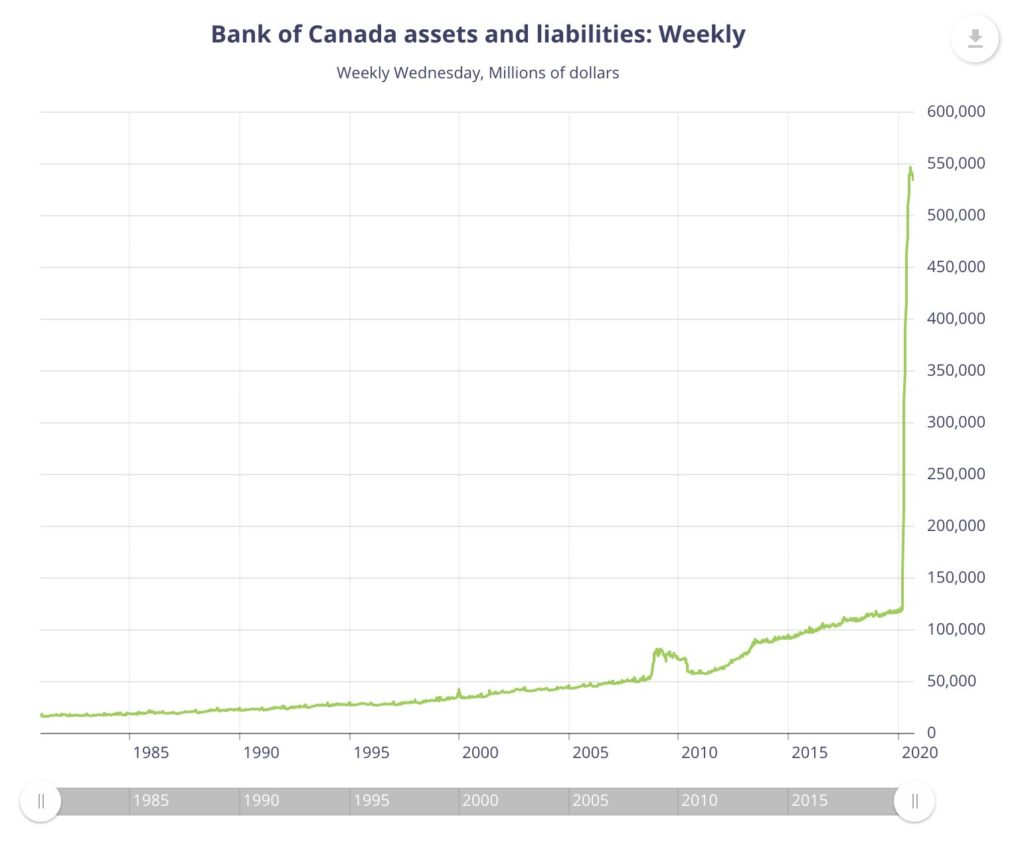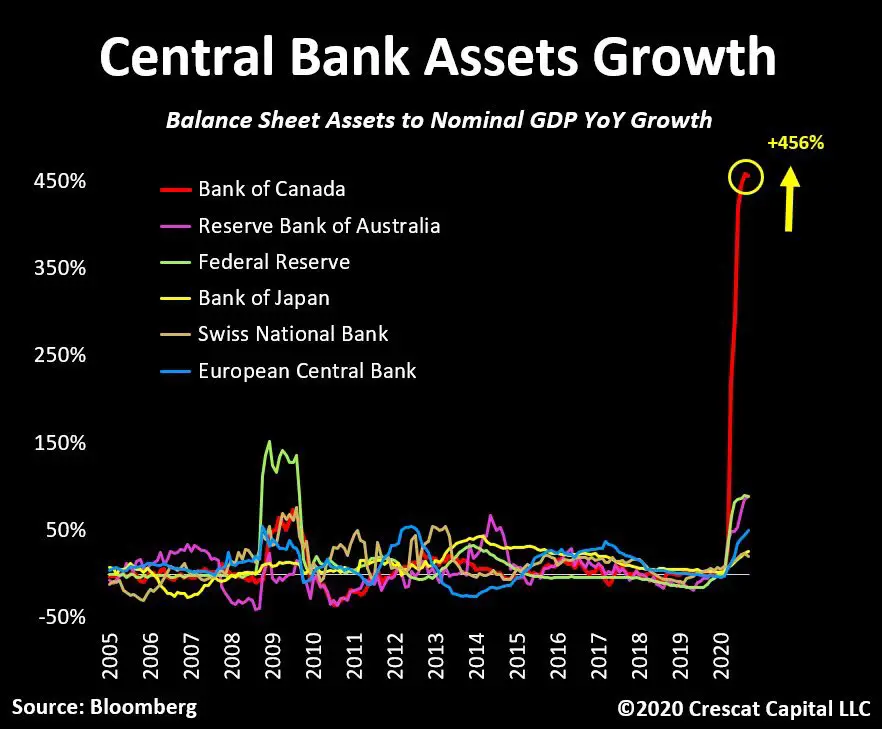Government spending and money printing can only paper over the underlying reality for so long: A country with thousands of shuttered businesses, weakening productivity, and immense debt burdens at all levels is a country in serious danger.
We tend to think the future will look exactly like the past.
But that’s often not the case.
And when we think of an economic crisis, we tend to think of the Great Depression, assuming that things will look the same when a ‘crisis’ hits again.
Yet, governments now have many more tools to try and paper over the obviousness of a crisis.
For example, governments are far quicker to print money (or type it into existence on central bank computers), and give out cheques.
This can prevent the immediate crisis of people being unable to pay for things in the short term, yet the deeper problems in the economy can continue to worsen.
And that’s what we are seeing right now in Canada.
Canada is already in an economic crisis
Consider what what Pattie Lovett-Reid recently wrote for BNN Bloomberg:
“The party is over.
A new survey by MNP Ltd. has found that 53 per cent of respondents said they are $200 or less away from not being able to meet all of their monthly bills and debt obligations. The number is alarming as it marks a five-year high in the agency’s consumer debt index and marks a 10-point jump from a December survey.
This number includes the 30 per cent who said they are already insolvent, with no money left over at the end of the month.
Government support programs offered up a little financial flexibility over the past year but, at best, these programs were intended to be temporary. In many ways COVID-19 benefits masked the seriousness of Canadians who were drowning in debt.
“The anxiety Canadians are feeling about making ends meet – or already unable to do so – tells us we may eventually see an avalanche of households falling behind on payments or defaulting on loans, mortgages, car payments or credit cards,” said Grant Bazian, president of MNP LTD, in the report published Thursday.”
Consider that this past year has witnessed the largest expansion of government deficits in Canadian history.
And central banks have intervened at an astounding rate, with the expansion of the Bank of Canada balance sheet boggling the mind:

While most central banks expanded their balance sheets, the Bank of Canada stands out:

For a long time, we’ve heard people say economic problems can be fixed simply by the government printing money and sending it out to people.
Yet, with more Canadians on the brink of insolvency after a year in which governments spent more than ever before, that idea has been severely discredited.
The key reason for all of this is that an economy must – at a fundamental level – be based upon real productivity.
Real things have to be created.
Real services have to be provided.
A real exchange of value must take place.
If 10 people were on an island untouched by civilization, they could use rocks as currency, find a huge new stack of rocks, give all those rocks out to everyone, yet still have nothing to eat or trade. Before money has meaning, there must be productive activity.
With tens of thousands of businesses being repeatedly locked down and destroyed completely – especially small businesses which are the engine of Canada’s economy – productive activity has declined dramatically, and Canadians have become worse off.
And of course, a massive expansion of the money supply leads to rising inflation – also known as ‘the hidden tax.’
A growing disconnect between government stats, and our experience on the ground
We are expected to believe that inflation is staying ‘steady’ around 2%.
We are also expected to believe that our economy is going grow by around 5% next year.
And, we are expected to believe that continued deficit spending will cure what ails the economy.
Do you believe that?
On the first point, I don’t know anybody who actually thinks inflation is steady or is just 2%. Housing prices are out of control, and food has become more and more expensive. A new Canada Fuel Standard is an additional carbon tax, on top of the current carbon tax which is going up this year, and set to keep going up. There’s no way inflation is remaining steady or low, and it would be absurd if it did, since the government is printing so much money without a corresponding increase in real productivity, so more money chasing a supply of goods growing at a smaller rate will inevitably lead to inflation and a devaluation of our money.
It’s also no surprise that this rush of deficit spending and money printing coincides with Bitcoin, Ethereum, and other cryptocurrencies rising, as people are losing faith in the credibility of fiat money.
On the second point, it is actually quite possible the economy will technically grow somewhere around 5% next year. Money printing, surging inflation, an out of control housing market, a large immigration increase, and deficit spending can certainly generate a year or two of ‘growth.’
But as we see in the rising number of Canadians facing insolvency, that ‘growth’ won’t reach most people in this country, and will be based upon dubious foundations.
Real, sustainable, economic growth is based upon rising productivity. There is no way around that in the medium to long-term. Thus, any temporary surge in growth that isn’t accompanied with a productivity increase is in effect stolen from the future, and must be paid back.
This is where comparisons to the ‘New Deal’ and WW2 era of gargantuan GDP growth in the US and Canada isn’t applicable here.
That period saw transformative increases in assembly line efficiency, millions of new workers become employed for the first time, and the productivity of real, tangible products – a creation of value that was produced by many people who had previously been unemployed and thus had been producing no value. It’s telling that the economy continued to be strong even after the war, as the increase in productive capacity was easily retooled towards domestic manufacturing.
Today, we don’t see anything similar.
Government deficit spending has been less about tangible infrastructure, and more about simply printing money, giving it out, and paying for the rising cost of government.
And that brings us to the third point, the idea that deficit spending is all we need to fix the economy.
Simply put, it doesn’t work that way, particularly when that spending isn’t being used to increase productivity.
We are seeing something unprecedented, where governments – especially in Canada – impose restrictions on the economy (ostensibly to fight climate change), that raise the cost of living and lower productivity, while simultaneously trying to deficit-spend their way out of the productivity problem.
It’s the worst of both worlds: Deficit spending that raises debt and adds thus takes money out of productive use (going towards debt payments instead), and policies that restrict real productivity growth, making that debt less and less affordable over time.
Again, in the WW2 era that big spenders love to reference, governments pulled out all the stops in an effort to generate maximal economic activity, something we don’t see happening today.
An economic crisis is taking place
In effect, Canada is experiencing an economic crisis in all but name, with the damage taking place ‘behind the scenes’ and in slow motion.
A rising number of people are dependent on government money to make ends meet.
Debt is rising at the individual level, the corporate level, the provincial level, and the federal level.
Productivity growth is stagnant.
Housing is increasingly unaffordable, with more and more Canadians being pushed out of our own cities.
High unemployment is masked by the rising number of precarious jobs, jobs that would barely be considered employment in previous eras.
In short, Canada is in a very dangerous position, a position made all the more dangerous by the concerted efforts of governments, corporate elites, and the Bank of Canada to try and paper over what is really taking place by applying a false veneer of prosperity onto a severely declining system.
Spencer Fernando
***
Did you find value in this column? If so, your financial support is greatly appreciated. You can contribute through PayPal, or directly through Stripe. Thank you.
[simpay id=”28904″]